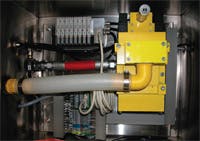Manufacturers of packaging equipment provide a system of guards to limit access to potentially dangerous work areas of a machine. Where periodic access is required, doors made of clear, high-strength plastic with safety interlocks cut off electrical power.
Most machines also incorporate a 3-port, 2-position normally closed poppet valve as a main air dump valve to also shut down pneumatic power. This valve is also de-energized when a door is opened. A separate, identical valve is also provided for emergency stops.
A case study
A packaging machine original equipment manufacturer (OEM) was approached about using safety related products to help meet ANSI/PMMI B155.1-2006: Safety Requirements for Packaging Machinery and Packaging- Related Converting Machinery. The machine builder claimed that its system was category 3, based on the fact that two valves are used for separate safety functions — providing redundancy.
The state of a low-level pressure switch provided feedback to the machine’s the control system. Company officials also specified in product literature that the end user should test each valve that monitors devices every day.
A look at the safety standards
Section 6.8 of PMMI B155.1-2006 covers documented risk assessment. Therefore, OEMs should have their valve selection justification documented for end users. Section 7.2 covers control systems and states clearly that pneumatics is part of the control system. For example, Section 7.2.1 states, “The design measures of the control system shall be chosen so that its safety-related performance provides a sufficient amount of risk reduction.” Furthermore, Section 7.2.9.2, covering stop functions, states “When pneumatic/hydraulic valves are incorporated into a safety stopping function, they shall be redundant and monitored for both fault and diminished performance as determined by the risk assessment.”
Section 5.4.3.2 of ANSI/ASSE Z244.1 discusses control circuit integrity for alternative lockout, which can only be used for production related tasks that are routine, repetitive, and integral to production.
ISO 13849 section 6 defines categories 1-4, which are typically used by the safety community. This ISO will replace EN 954, but the categories basically remain unchanged. “Category 2 shall be designed so that their function(s) are checked at suitable intervals by the machine control system... Category 3 shall be designed so that a single fault in any of these parts does not lead to the loss of the safety function. Whenever reasonable and practicable, the single fault shall be detected at or before the next demand of the safety function.”
Applying the standards
The argument against the OEM’s practice for its packaging machine standard was that it was using two non-monitored devices. At best, it met level b of ANSI Z244, alternative lockout, where simple redundancy is allowed for this production related activities. It did not meet category 2 from ISO 13849/EN 954 because category 2 requires monitoring by the control system, and the valves’ functions were not monitored by the control system. Category 3 states that the fault must be detected before the next demand of the safety function.
A stuck valve would not be detected until the user manually tested it according to the manufacturer’s instructions, assuming the user performed this manual test daily as suggested by the OEM. These valves appeared to be used for the stop function because they were integrated to the door opening interlocks and played a direct role in removing the fluid power causing motion in the machine. It did not meet the PMMI standard for stop function because the exhaust valves were not individually monitored and were in no way monitored for diminished performance.
The OEM’s web page indicated it used Allen Bradley electrical safety related components that carry the certifications associated with them. The OEM was not trying to create an electrical safety circuit using nonsafety rated devices. Furthermore, in literature for the valves that had been used is the following statement on the warranty page: “Warning: Under no circumstances are mac® valves to be used in any application where failure of the valve to operate as intended could jeopardize the safety of the operator or any other person or property.”
The OEM’s solution, although commonly used and not atypical, was not a category 3 system and did not meet the standard requirements for the machine.
Arriving at a solution
The OEM could have specified the Ross Controls’ SV27 valve, which contains a switch that allows monitoring by the safety control system. However, two valves would be needed to meet the redundancy requirement, and the monitoring system would have to monitor for diminished performance in the valves.
Ross Controls’ DM2 valve provides redundancy, monitoring, and monitoring for diminished performance all within a single valve. While emergency stop and machine guarding are separate safety circuits, they do not require completely separate components for all functions and the DM2 could be used by both systems to block the pneumatic supply and remove downstream stored energy from the machine.
A single device, the DM2 can replace the two separate devices that had been used and improve the safety of the machine to bring it into compliance for the pneumatic requirements of the ANSI/PMMI standard that covers this machine.
This information was provided by Ross Controls, Troy, Mich. For more information on Ross’s DM2 valves, or other products or services, call (800) 438- 7677 or visit www.rosscontrols.com.


